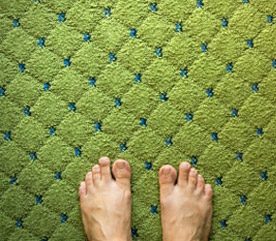Carpet Quick Fixes
Ahh, the luxurious feel of carpet under your feet. Enjoy it pampering your feet for years by following these tips to extend the life of your carpet.

Keep Your Socks On
Sure, it feels great to pad around barefoot on carpet. Trouble is, oil from your bare feet rubs off onto the fibres. Dirt sticks to the oil, shortening the life of your carpet. So while it is kind to your floors to take your shoes off when you enter the house, leave your socks on to protect the carpet.
Don’t Vacuum Antique Oriental Rugs
The strong suction and rotary brush on your vacuum will shorten the life of valuable Oriental rugs. Instead of vacuuming, send these rugs out to be professionally cleaned. Look under the listing for carpet and rug cleaners in the yellow pages. Make sure they know how to handle Oriental rugs.
Vacuum-Whether It Needs It or Not
A good vacuum will remove 85 percent of the dirt in a carpet, so frequent vacuuming is the best way to make your carpet last. It’s important to have the right vacuum-the best is an upright designed for carpeting, but a motorized attachment for a canister-type vacuum is almost as good and has the advantage of being able to reach farther under furniture. Both types have a rotary brush, designed to loosen the dirt in carpet. Keep in mind that as the bag fills up, the suction power reduces, so change your bags when they are about half full.
Steam-Clean For New Life
Even with regular vacuuming, dirt eventually works its way deep into the pile where the vacuum can’t reach. To really renew your carpet, steam-clean it every 6 to 18 months. You can rent a steam cleaner and do the job yourself, but for the best results, hire a professional carpet-cleaning company. The pros will swoop in with a big truck, get the job done and get out of your way.
Change Traffic Patterns
Changing the traffic pattern on the carpet will distribute the wear, making the carpet last longer. If it is a movable rug, rotate its position in the room. For wall-to-wall carpeting, move your furniture to change the traffic pattern.
Avoid Direct Sunlight
To keep carpet from fading, protect it from direct sunlight by closing drapes or blinds during peak sunlight hours.
Don’t Skimp on the Padding
Besides making carpet feel more luxurious, top-quality padding will make your carpet last longer.
Steam Out Furniture Footprints
Are you left with furniture footprints in your carpet after rearranging the room? Use a steam iron to bring the crushed fibres back to their original shape. Just set the iron on steam, and hold it about ¼ inch above the carpet. Use a screwdriver to help flush out the fibres.
Don’t Drag the Furniture
Be sure to pick up the furniture the next time you rearrange a carpeted room. Dragging furniture over carpet causes unnecessary wear. Moreover, if the carpet is nylon, the friction caused by dragging can actually melt the fibres.
Snip Off Burns
Singed carpet is no tragedy. Just snip off the charred tips of the tufts with a pair of sharp scissors. If the carpet is plush, it helps to feather out the area by lightly tapering the nap in a circle a little wider than the damaged area.
The Cookie-Cutter Patch
If a small section of carpet is so badly stained that you can’t clean it or is burned too deeply to snip off the damage, you can still fix it easily enough, thanks to spot-patch repair kits. The kits come with a circular tool with a center pivot and a blade attached to the outside. You just rotate the tool to cut out the damaged area; then do the same to cut a patch from spare carpet. Put down double-stick tape that comes with the kit, plug in the patch, and that’s it! If you don’t have spare carpet, you can steal a patch from a hidden area. The inside of a closet is usually a good choice.
Sew Up Seam Tears
Most carpet tears happen along seams where two pieces were originally glued or sewn together. To fix a tear along a seam, thread some heavy fishing line through a curved upholstery needle. Stitch the tear together, pushing the needle through about ½ inch from the edges of the tear and spacing the stitches about ¾ inch apart. The top of the stitches should be square to the tear-the underside diagonal-for the least visibility. If you are rejoining a seam that was once glued together, you’ll find the old glue tape tough to work the needle through. Use needle-nose pliers to help push the needle.
Shop at the readersdigest.ca online store for best-selling gardening and home décor books and DVDs.



